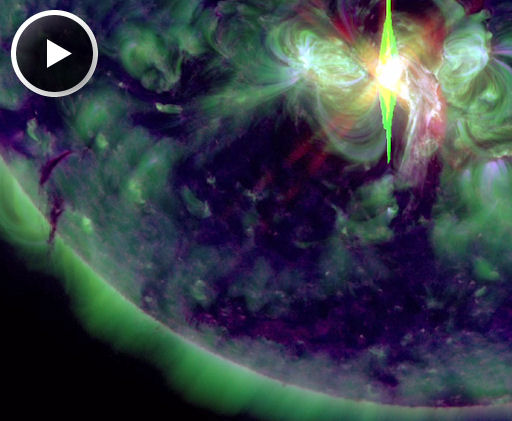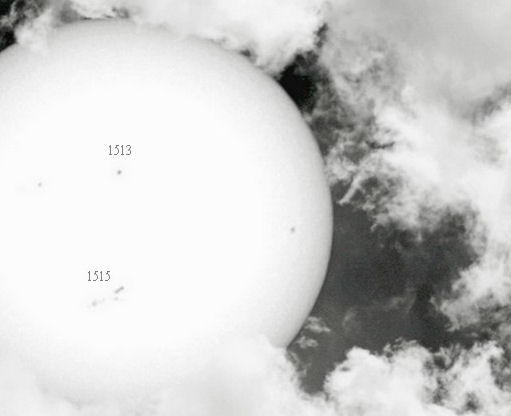ALMOST X-FLARE: Big sunspot AR1515 erupted on July 2nd at 10:52 UT, producing an M5.6-class solar flare that almost crossed the threshold into X-territory. NASA's Solar Dynamics Observatory recorded the extreme ultraviolet flash:
A pulse of x-rays and UV radiation from the flare illuminated Earth's upper atmosphere, producing waves of ionization over Europe. Such waves alter the propagation of low-frequency radio transmissions. In Lofoten, Norway, Rob Stammes recorded the ionospheric disturbance using a 60 kHz receiver: data.
The eruption also hurled a CME into space, but not directly toward Earth. The south-traveling cloud could deliver a glancing blow to our planet's magnetosphere on July 4th or 5th. Stay tuned for updates. [SDO movie]
Realtime Space Weather Photo Gallery
BIG SUNSPOTS: The solar disk is peppered with sunspots so large onlookers are seeing them with the naked eye. Earlier today, the clouds over Paris, France, acted as a natural solar filter to reveal active regions AR1513 and AR1515:
VegaStar Carpentier took the picture using an off-the-shelf Canon EOS 1000D digital camera set at ISO 100 for 1/80 of a second. Photographers, take note of those settings because the sunspots should remain large and obvious for at least a few more days. (Caution: Do not look at the unfiltered sun through camera optics because focused sunlight can damage your eyes. Use the LCD viewscreen for pointing.)
The sunspots are also showing up in sunrises and sunsets around the world. Browse the Realtime SpaceWeather Photo Gallery for more examples.

![]()
Solar wind
speed: 523.9 km/sec
density: 1.6 protons/cm3
explanation | more data
Updated: Today at 1455 UT
![]()
X-ray Solar Flares
6-hr max: C4 1359 UT Jul03
24-hr: M1 0000 UT Jul03
explanation | more data
Updated: Today at: 1400 UT
![]()
![]()
![]()
Daily Sun: 03 Jul 12
![]()
![]()
Sunspots 1513 and 1515 have 'beta-gamma' magnetic fields that harbor energy for M-class solar flares. Credit: SDO/HMI
![]()
![]()
![]()
Sunspot number: 165
What is the sunspot number?
Updated 03 Jul 2012
Spotless Days
Current Stretch: 0 days
2012 total: 0 days (0%)
2011 total: 2 days (<1%)
2010 total: 51 days (14%)
2009 total: 260 days (71%)
Since 2004: 821 days
Typical Solar Min: 486 days
Updated 03 Jul 2012
The Radio Sun
10.7 cm flux: 166 sfu
explanation | more data
Updated 03 Jul 2012
![]()
![]()
![]()
Current Auroral Oval:
![]()
Switch to: Europe, USA, New Zealand, Antarctica
Credit: NOAA/POES
![]()
![]()
![]()
Planetary K-index
Now: Kp= 2 quiet
24-hr max: Kp= 3 quiet
explanation | more data
![]()
Interplanetary Mag. Field
Btotal: 3.8 nT
Bz: -0.0 nT
explanation | more data
Updated: Today at 1456 UT
![]()
![]()
![]()
Coronal Holes: 30 Jun 12
![]()
![]()
Solar wind flowing from this coronal hole should reach Earth on July 2-3. Credit: SDO/AIA.






